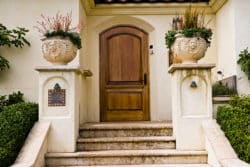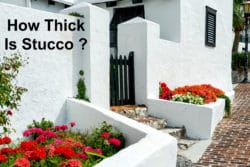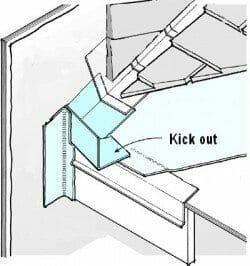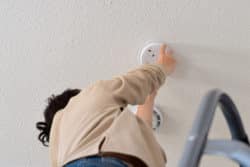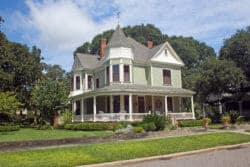Cracks and Problems with EFIS Synthetic Stucco | When Serious
Homes with EFIS Synthetic Stucco that have cracks, improperly sealed penetration’s and moisture trapped behind the lamina can have serious problems. Knowing what warning signs to look for, where to look and the cause of the problems will assist you in assessing if they are serious, minor or if you’re just looking at a maintenance issue.
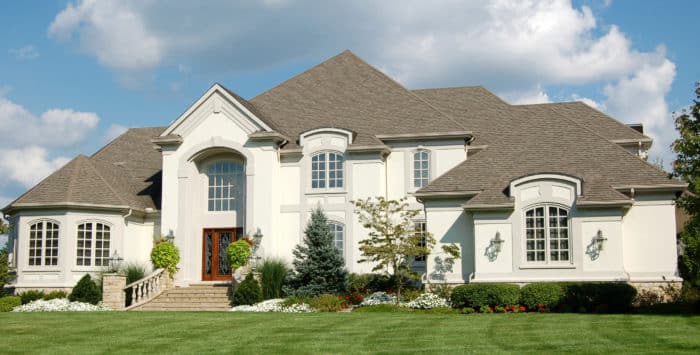
For clarity it is important to understand that an EFIS Synthetic Stucco wall is really a group of different layers that makes up an assembly or system. This is what engineers, contractors, architects, and the code addresses: note that an EFIS system is considered a type of stucco “Cladding.”
The age of a home plays an important part in evaluating cracks and moisture intrusion in EFIS synthetic stucco systems
EFIS Synthetic Stucco was developed and used in Europe after World War II and then in the mid 1960’s began being used in North America. It grew in popularity, partially driven by energy cost and requirements, as well as being much lighter in weight which made it popular in the commercial building market. Due to its insulation qualities and code changes in energy requirements in residential housing, the use of EFIS increased tremendously and around 1995 reached a peak.
In the mid 1990’s the EFIS industry began experiencing a considerable amount of problems relating to leaking, moisture intrusion, assembly failures, poor workmanship and a large amount of litigation involving large settlements or payouts. So much so that insurance companies made significant policy changes. Eventually, the EFIS industry made considerable changes on how the EFIS systems were designed and these design changes, as well as code changes, resolved a number of the problems related to the systems, but not all. Since that period, the use has dropped considerably in the residential market and now is estimated to be around 4% to 5% of the residential market.
First – How to tell if your house has an EFIS Synthetic Stucco System

It is hard to tell if you have an EFIS synthetic stucco system by merely looking at it. However, there are a number of ways to tell but the two most common ones are:
#1 How the wall feels with your finger
Take your finger and push on the stucco wall in several places. If the wall feels just a tiny bit soft and it doesn’t feel really hard like concrete. Then it is probably EFIS.
#2 How the wall sounds
If you tap on the wall with your knuckles, like you were knocking on someone’s door and it has a little bit of a hollow sound, rather than what you might hear when knocking on a solid concrete wall. Then, it’s probably EFIS.
Caution
If you rub your finger along the wall or knock too hard with your knuckles you may injure your finger or knuckles, for stucco often has a rough type of texture, not a smooth one like glass. Although a few stucco walls will have a hard troweled smoot finish.
Other ways to tell
There are a number of other ways that might work better for you. Read about them.
What does EFIS stand for?
It is an acronym for “Exterior Insulation and Finish Systems. At times you hear people refer to an EFIS synthetic stucco wall by other names like “Dryvit” or mistakenly as “stucco,” but Dryvit Systems, Inc. is a manufacturer of EIFS products. Other manufactures or trademark names that may be synonymous are StoCorp, BASF, Master Wall, Parex and Master Builders Solutions.
What does an EFIS systems go over?
THINK LAYERS
#1 A substrate
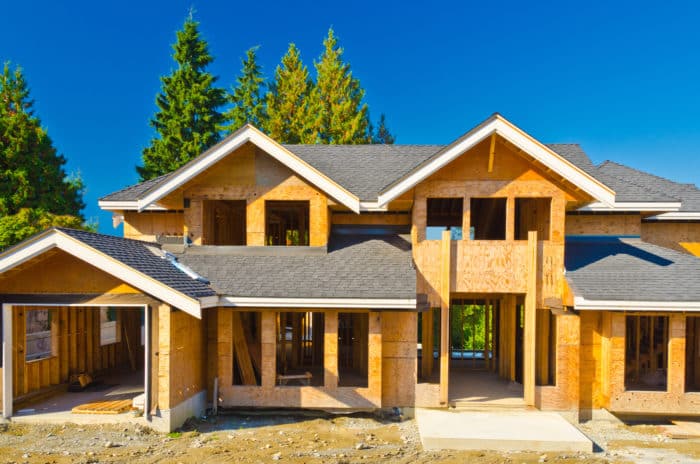
Plywood or OSB (oriented strand board)
The most common for residential construction is metal or wood framed walls with a substrate of plywood or OSB covering the framed wall. There are also other approved materials that may be used for a substrate on metal or wood framed walls. One popular one is exterior gypsum sheathing which has a noncombustible, moisture-resistant core wrapped in fiberglass facers or covered with other moisture resistant material on both the front and back surfaces and long edges.
- Other substrates materials include:
- Masonry block
- Concrete
- Plaster
- Brick
#2 Over the substrate goes the EFIS System
Drainage and Moisture Protection
In the past moisture getting trapped in the assembly was a significant problem but over the years there have been modifications to the code and in the EFIS assemblies that have reduced this problem.
Now EFIS systems tend to use assemblies that help prevent or reduce moisture migration or entrapment through having a drainage cavity / drainage plane or a material that allows moisture to basically drain though them to the bottom of the wall where the moisture exits.
The substrate may have a water-resistive barrier (WRB) that covers the substrate and then a drainage cavity / drainage plane and the insulation board. Codes and the climate zone that a home is in will often determine the configuration and materials used.
#3 – Insulation board next
The insulation board is next. It is typically made of expanded polystyrene (EPS). It may be ¾ inch thick or several inches thick, depending on what R value the engineer is seeking. The maximin thickness of an EFIS system is normally 4 inches by the code.
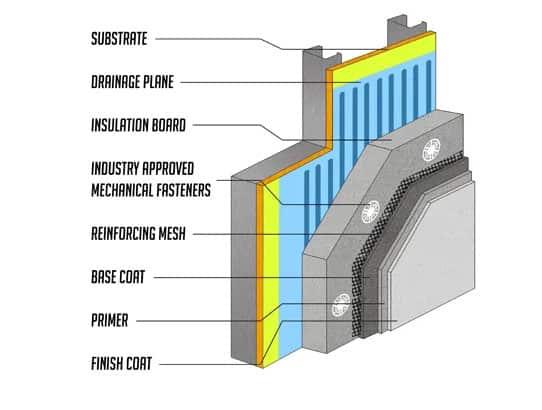
#4 – Reinforcing fiber mesh embedded in a base coat
Normally a fiber glass type of mesh is embedded in the base coat. The mesh, when embedded in the base coat strengthens the finish coat and helps provide a more weather resistive assembly.
#5 – Finish Coat or Lamina
The finish coat is a little like a heavy paint material that has color, often with a sandy aggregate type of material in it. This may be applied with a sprayer or troweled on. The end product looks much like traditional hard coat stucco.
Note about #4 and #5 One of the main purposes of the base coat and the finish coat is protection from the weather. Its intent is to prevent rain and wind from entering into the assembly.
Codes and the date your home was built is important in understanding the problems you may have with an EFIS synthetic stucco system
Knowing when your home was built is important when it comes to understanding what problems may exist and why.
In 2000 the code changed

The first generation of EFIS (before 2000), used the outer finish coat of the wall as a moisture barrier and there was no secondary moisture barrier required. The outer EFIS coat basically was the barrier for all moisture and if moisture did penetrate the EFIS finish coat through cracks or other penetrations, which was very common, there was no secondary back-up to prevent the moisture from getting into the home and drywall. This was a serious flaw. Contractors may refer to a EFIS system before 2000 as a “Barrier EFIS system.”
Thus, if your home was built before the 2000 code changes took effect, there was a high risk of moisture intruding into the wall cavity. This often caused mold, wood rot, as well as other damage.
Note. Prior to the late 1990’s, most residential EIFS did not incorporate a moisture barrier behind the system.
2009 Code
With the adoption of the 2009 code most residential homes were required to have:
- a drainage plane and
- a continuous water-resistive barrier
This was to be installed between the EFIS and the homes’ exterior sheathing. The WRB is often installed over a plywood or OSB substrate. Having both the drainage plane and the WRB helps to provide a path for trapped water to exit a wall assembly and reduces damage to the substrate.
Therefore, if your home was constructed after the 2009 code changes were implemented, your risk level of moisture intrusion damage from the EFIS system may be significantly lower than before, but still a homeowner should periodically look for issues and keep the EFIS wall well maintained.
Moisture is the number “One” issue with EFIS
A – Moisture getting into an EFIS assembly
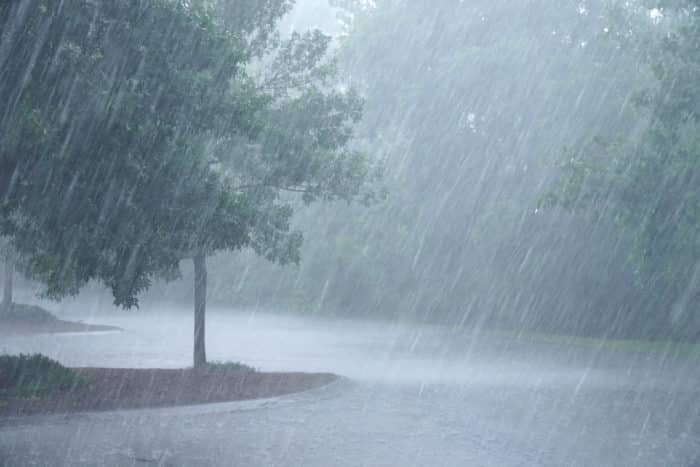
Water getting into an EFIS wall assembly is a major concern. Whether it comes from cracks, gaps where there are penetrations in the wall, a result of ageing, damage to the finish coat, poor workmanship, or a host of other causes. Reviewing these causes will help you discover problems, determine the seriousness, and decide what to do.
B – Moisture being trapped in a EFIS wall assembly
Another concern with an EFIS system is for water to get trapped in the wall assembly. This can happen in a number of ways. To start with, most of the EFIS systems in homes built before the 2009 code, did not have a proper “Drainage Plane” as part of the EFIS system.
Should moisture become trapped in the wall assembly or penetrate through the wall assembly, two serious concerns come to mind.
Mold and Mildew
Moisture trapped in areas where there is no sunlight, ventilation or method to escape can result in mold and mildew and we all know that this is a health issue. Those with respiratory issues can get quite ill or have breathing problems.
Dry rot and wet rot
Both of these may occur when water is trapped in a wall and in the presence of wood. Wood sheathing (plywood or OSB board), often part of the substrate that an EFIS assembly is over and wood framing members, such as studs, headers and beams, can deteriorate and loose much or all of their structural strength over time. The most common source of water getting into an EFIS wall is rain, but there are others, such as a sprinkler system spraying the stucco wall, unsealed gaps around pipes entering the wall or caulking failures around windows and doors.
Causes of cracks and damage to EFIS walls
#1 Impact damage
EFIS is susceptible to impact damage for several reasons. The main two are the thinness of the stucco finish coat, approximately 1/16 of an inch and the softness of the foam layer behind it. The combination of a thin coat of synthetic stucco over a soft Styrofoam type of material fails to provide the strength and hardness of a 7/8 inch thick Traditional hard coat stucco wall. Once cracked or damage, it provides another area for moisture intrusion.
Impact damage can occur for many reasons, just a few are:
- Hail hitting the wall in a storm: it can crack windshield, windows and EFIS
- Tree branches or limbs rubbing or hitting the wall
- Getting hit by a stray baseball when kids are playing
- Basketball hoops above a garage door, the constant banging of the ball
- If you live on a golf course, errant golf balls
- Even a ladder hitting a wall while cleaning gutters or putting up holiday decorations
Once the wall is damaged, water can easily intrude.
#2 Movement of the structure
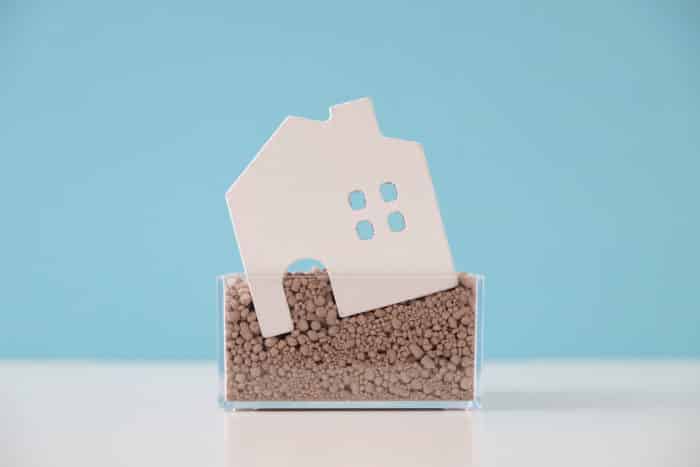
When a structure moves or shifts, usually this will cause movement of the wall which the EFIS system is attached to. This results in different forms of stress on the wall, which then will cause cracks.
What causes movement of a structure
First, if the soil under a foundation moves, then everything on top of the foundation moves and that includes the wall which the EFIS system is attached to. Common causes of foundation movement are:
- Settlement
- Expansive soils
- Slope creep
- Landslides
- Earthquakes / seismic movement
#3 Thunder Storms, Tornadoes and Hurricanes
Storms put substantial pressure on a home’s wall surface. Forces that can cause cracking, as well as other damage to the outer layer of a EFIS wall assembly and at times, the inner layers.
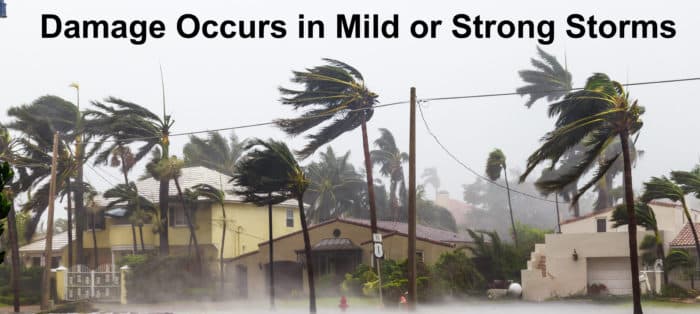
Thunder storms, wind loads, tornados and hurricanes
The stress that are put on a home’s wall in a strong thunder storm, hurricane or tornado can cause extensive damage to EFIS synthetic stucco walls. Since stucco is a brittle product, it may crack from these stresses, especially when a walls’ framing members flex, twist or bow; for stucco is not flexible. It has a very low level of elasticity.
Not only movement of the wall system is a concern, but the damage from flying debris hitting the wall. Think of a major league baseball pitcher hurling a hard ball at 90 miles per hour or faster against the side of your house; damage is going to occur. Flying debris in a storm does the same thing.
Tornadoes
Although the speed that it travels in its path averages around 30 miles per hour, the speed of the wind in the tornado is much higher, depending on the category of the tornado. They are often measured between EF – 0 up to an EF – 5. The range for these categories are 63 mph to over 200 mph.
In an EF-2 and EF-3. The wind will range from 111 to 165 mph, homes in these categories may suffer considerable damage. Including large trees snapping, lose debris becoming flying missiles and cars being lifted off the ground.
Hurricanes
In hurricanes winds may blow for long periods of time and often damage a home, including roofs and walls. In conditions where the winds reach 130 to 160 mph, at least one half of the homes are expected to have wall and/or roof failures.
Tornadoes are linked with powerful updrafts of wind, so rain generally does not impact EFIS stucco nearly as much as hurricanes and thunderstorms which deliver vast amounts of water against a wall. Vast amounts of water against an EFIS assembly will often penetrate the assembly.
#4 Ageing of the EFIS
Embrittlement and hygric (moisture) damage to EFIS
As EFIS ages over the years it causes stress on the outer layer of a EFIS system. This stress is generated from hygric (moisture) or thermal stress or it may be from both, which in the end, results in cracks. Ones, that at first, are miniscule micro-fractures which are not visible to the eye, because they redistribute the stress throughout the coating. Overtime though, visible cracks may start to appear i.e. at window and door corners.
During this process moisture may deteriorate the strength of the mesh embedded in the base coat and the thermal effects of the sun, including the UV rays from the sun. All of these weakens the base and finish coat. Note, about 10% of the sun’s rays are UV rays and only about 1/3 of these reach the earth’s surface.
The hygric and thermal stresses over years may result in an embrittlement process that weakens or deteriorates the base coat and finish coat, leading to cracking and moisture intrusion into the entire EFIS assembly itself.
#5 Moisture
In the big picture all cladding systems have a problem of moisture getting through them or around them, an EFIS system is no exception.
Common areas for moisture intrusion:
- Around doors and windows
- At penetrations in a wall, i.e. gas, electrical or water pipes
- Changes in cladding materials
- Missing or improperly installed flashing
#6 Poor workmanship
An EFIS synthetic stucco system is a proprietary system and all materials used must be consistent with the specifications required of that proprietary EFIS system. Additionally, how the materials are to be installed must be by the manufactures recommended installation instructions, which are usually many pages long and somewhat complex.
Due to the complexities of the installation requirements a higher skilled work force is normally required. Not many tradesmen are trained and skilled in working with EFIS systems.
When a case goes to court over a failure of the system, much of the case revolves around a contractors’ failure to follow the complex manufactures instructions.
Where to look for cracks and other signs that you have a problem

There are a number of areas that a homeowner should look for signs that there is or may be problems of one type or another.
Door and window corners
The most common place that cracks appear in an EFIS assembly is at window and door corners, for the corners are one of the primary locations for stress to build up. Once the stress levels are strong enough, the EFIS will crack. By cracking, the stress is reduced or is eliminated.
Check the decorative foam trims and other foam features
There are a number of manufacturers and suppliers of stucco coated foam trim, moldings, sills, columns, shutters and many other architectural decorative shapes. These products are adhered to the wall and then the finish coat is applied. A crack may appear at this joint where the trim is adhered to the wall. It often looks like a hairline crack, but water may seep into the wall through it.
Cracks or gaps where two different types of cladding meet
Where an EFIS assembly meets another type of cladding, i.e. a wood, stone or brick cladding, there may be a crack or gap that develops over time. A perfect place for water to creep in if the transition is not installed or sealed properly.
Areas where flashing was installed improperly or is missing Moisture often finds its way into a wall where a deck or balcony is connected. It is not uncommon for proper flashing to be missing or installed wrong. Another common area is where a “kicker” is missing or installed improperly.
Pipes or other penetrations
Kitchen or bathroom vents running out through a side wall may not be sealed well and have a small gap. There may be a gap where a gas or water pipe runs through a wall or where an electrical conduit penetrates it.
Wall lighting fixtures
Exterior wall light fixtures may have gaps around them where water can leak in or the caulking may have dried out or deteriorated.
Moldy odor or moisture stains on the interior drywall or around openings in a wall (i.e. windows) can be a warning sign of an EFIS problem or leak
If there is a moldy odor or a moisture stain, there is a possibility that it is because there is a leak or gap through the EFIS assembly where the water is getting in. We must keep in mind though, that the stain or odor may be the result of a plumbing leak or from some other cause.
Large wall areas with no control joints
If a EFIS wall is too long or high and there are no control joints per manufactures recommendations or per code, then it may crack due to stress buildup.
Fire considerations with EFIS
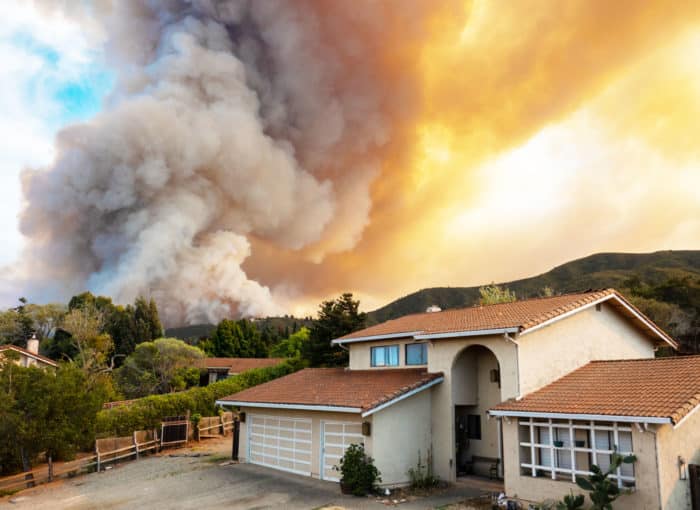
Homes that are currently built must meet various fire code regulations and EFIS systems do meet the minimum requirements. However, when an EFIS stucco wall system is compared with a traditional hard coat stucco wall, there are considerable differences in their resistance to fires. Traditional hard coat stucco is considered as non-combustional but an EFIS sysem is not non-combustionable. Several of the fire concerns with an EFIS system is the synthetic stucco of the finsh coat is only about 1/16 tgick and is composed of materials that are combustionable.
The foam board below this outer layer is also combustiable material. The majority of foam products are a problem in fires. Many EFIS systems uses an EPS type foam board, the foam often has a fire-retardant component which increases the temperature that the foam ignites and slows the flame spread, however, this only reduces the fire risk a small amount when compared to traditional stucco
Where there are cracks or damage to the finish coat, then a fire can reach the foam layer much quicker. Other factors of concern include the workmanship, is the lamina too thin, are there gaps between window and door edges that allow a fire to more easily access the foam layer, etc.?
The thicker the foam board insulation is, the more fuel that is available for a fire. Codes basically have a maximum thickness of 4 inches and it is not unusual for a building jurisdiction to require a fuel study on the thicker EFIS installations. If the wall construction was done without a permit and inspections and a fuel study would have normally been required, then there may be an additional fire safety concern.

If you have an EFIS synthetic stucco wall system, be vigilant about watching for problems. Try to catch them early and repair any damage or cracks in a timely manner, don’t put it off.
Check your homeowner’s insurance policy or contact your agent to make sure you have the proper type of insurance and there are not any exclusions regarding EFIS.
Keep the exterior area next to your home free of combustible materials. Trim or remove excessive shrubbery and preferably plant landscaping that is resistive to fire.
Make trees more wind resistant by removing diseased or damaged limbs, then strategically remove branches so that the wind can blow through; for strong winds frequently break weak limbs and hurl them at great speed, causing damage when they hit a home.
All home claddings have pro’s and con’s.
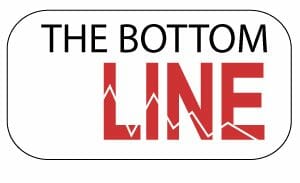
Pro’s
Homes with an EFIS synthetic stucco system provides the benefit of having thermal insulation as part of their wall assembly, the system is light weight and has a lot of architectural flexibility.
Con’s
An EFIS synthetic stucco system is more complex than many wall assemblies and requires a high level of skills to install than many. Thus, it is more costly than a Traditional hard coat stucco wall; plus, it does not provide nearly as much fire protection.
Older homes
Older EFIS homes are at higher risk of having moisture intrusion problems, especially if they were built before the year 2000 or before the year 2009 when major code changes took place. Homes built after 2009 are less likely to have some of the severe moisture issues that older homes experienced, however, there is always a concern of moisture getting trapped.
Maintenance of EFIS systems
A homeowner should always stay on top of their maintenance when they have an EFIS wall system, otherwise failure to do so can be costly.


